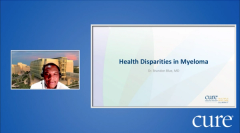
Educated Patient® Multiple Myeloma Summit MGUS/Smoldering Myeloma Presentation: April 8, 2023
Watch Dr. Ariel F. Grajales-Cruz, from Moffitt Cancer Center, discuss updates in MGUS and smoldering disease during the CURE Educated Patient Multiple Myeloma Summit.
Episodes in this series

Monoclonal gammopathy of undetermined significance (MGUS) and smoldering myeloma are both precursor conditions that can turn into multiple myeloma, a type of cancer that affects plasma cell production. As such, it is important that patients with these conditions undergo monitoring with their health care team to catch and treat myeloma early, explained Dr. Ariel F. Grajales-Cruz.
At CURE®’s Educated Patient® Multiple Myeloma Summit, Grajales-Cruz, assistant member of the Malignant Hematology, Myeloma Section at H. Lee Moffitt Cancer Center and Research Institute in Tampa, Florida, gave an overview of MGUS and smoldering myeloma.
“(Myeloma) starts with what we call a precursor state — MGUS or smoldering myeloma — and then after those precursor states, the patients have a (higher) statistical chance of developing multiple myeloma afterwards, which is the actual cancer with organ damage that leads to diagnosis,” Grajales-Cruz said in his presentation.
The defining criteria for MGUS involves patients having less than 3 grams per deciliter (g/dL) or the M protein, which is produced from abnormal plasma cell activity; less than 10% clonal plasma cells in the bone marrow; and no myeloma-defining health events.
Next, smoldering myeloma includes patients with 3 or more g/dL of the M protein in the serum or 500 or more g/dL over 24 hours within the urine; 10% to 60% clonal plasma cells in the bone marrow; and still no myeloma-defining events.
Both MGUS and smoldering myeloma lack symptoms defined by the CRAB criteria, which stands for calcium level elevation, renal (kidney) injury, anemia (low levels of hemoglobin in the blood) and bone disease, which are caused by the monoclonal protein in the bones.
But once a patient experiences one of these CRAB criteria and a myeloma-defining event (more than 60% plasma cells in the marrow, a free light chain ratio of over 100 or more than one bone lesion in an MRI, then they are officially diagnosed with multiple myeloma.
“And at that point, the patient unequivocally needs treatment,” Grajales-Cruz said.
However, the current standard of care for patients with MGUS and smoldering myeloma is to take a watch-and-wait approach.
Smoldering myeloma tends to progress faster than MGUS, with approximately a 10% and 3% yearly chance of each of the conditions, respectively, turning into myeloma, according to Grajales-Cruz.
“We have to gauge the pros and cons in terms of addressing a protein that is there, but not causing any damage,” Grajales-Cruz explained. “Is it reasonable to cause side effects with treatments?”
While the current standard is an active surveillance approach, ongoing trials are addressing whether medical intervention for patients with smoldering myeloma — particularly those with a high risk of developing myeloma — can improve long-term outcomes.
The QuiRedex Trial showed that patients with high-risk smoldering myeloma who were treated with Revlimid (lenalidomide) and dexamethasone were less likely to have their disease progress to myeloma than those who underwent observation. Additionally, the E3A06 trial showed a lower percentage of patients with smoldering myeloma who were given Revlimid experienced disease progression over the course of 35 months compared to those who were just observed.
Another trial, GEM-CESAR, showed that 94% of patients with smoldering myeloma did not experience disease progression at 70 months when given Kyprolis (carfilzomib), Revlimid and dexamethasone before melphalan and stem cell transplantation, followed by Kyprolis, Revlimid and dexamethasone consolidation treatment and then Revlimid and dexamethasone maintenance.
Finally, the ASCENT trial showed that Kyprolis, Revlimid and dexamethasone led to a progression-free survival rate (the percentage of patients with no disease worsening or progression following treatment) of 89.9% in patients with smoldering myeloma, including 84% of patients who were deemed minimal residual disease-negative, meaning that there were limited to no signs of myeloma cells found.
Other ongoing trials continue to examine different treatment regimens and their potential impact on patients with smoldering myeloma, Grajales-Cruz said.
“We have a lot of possibilities in the future,” he said. “We’re just trying to get better at treating myeloma altogether, and it starts with the precursor states.”
For more news on cancer updates, research and education, don’t forget to














